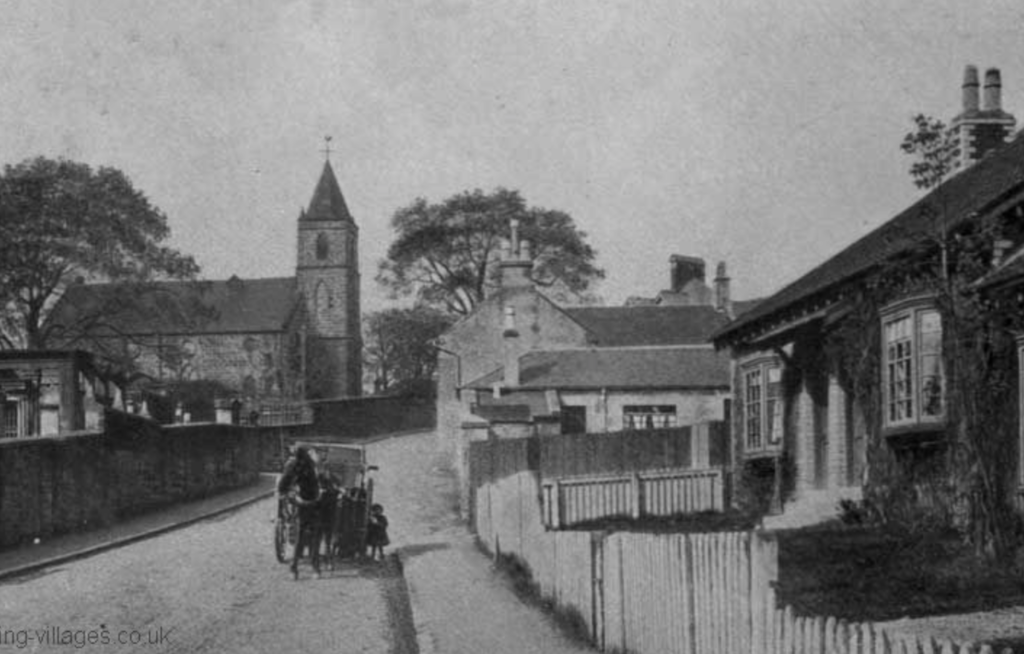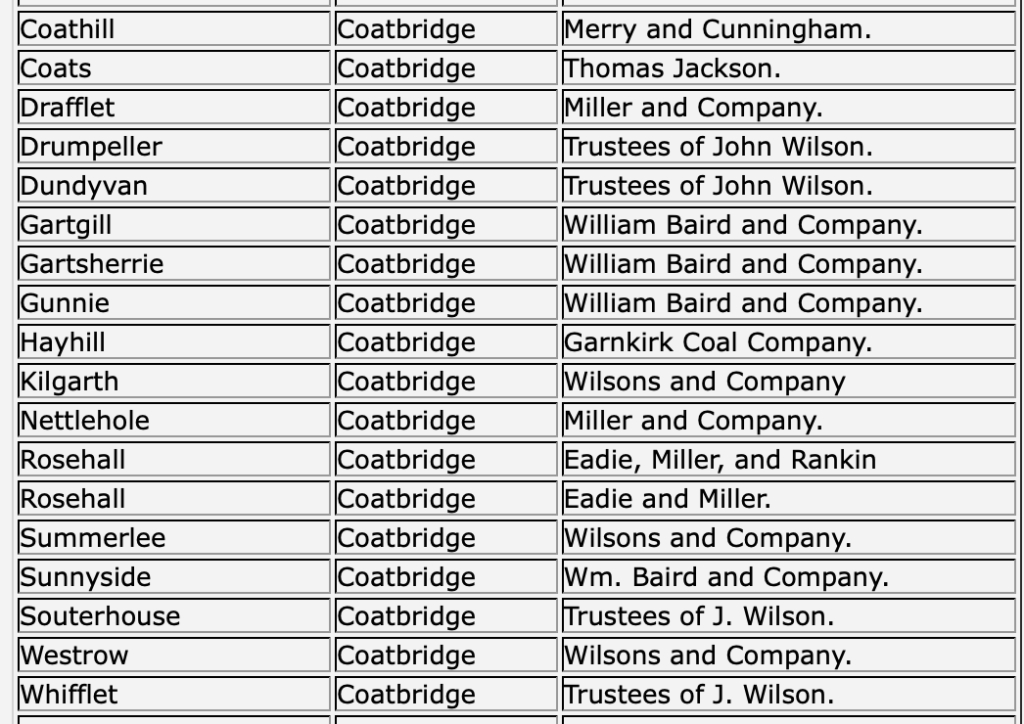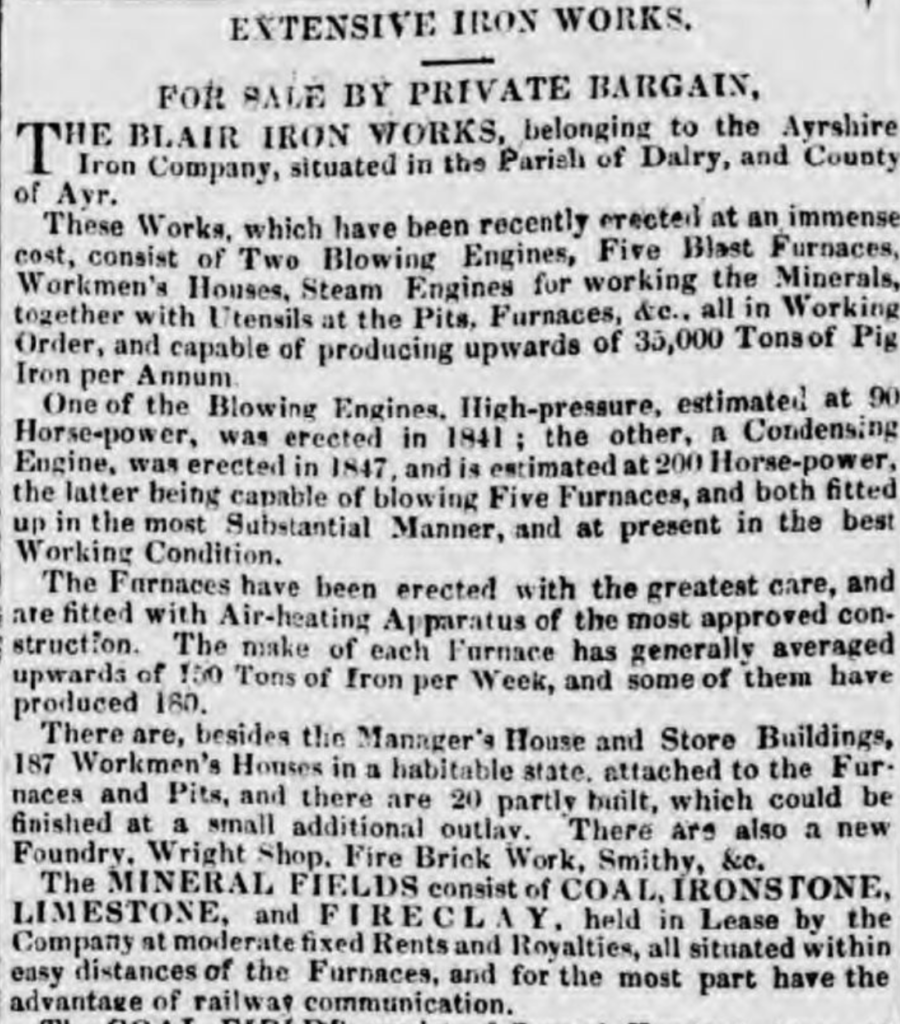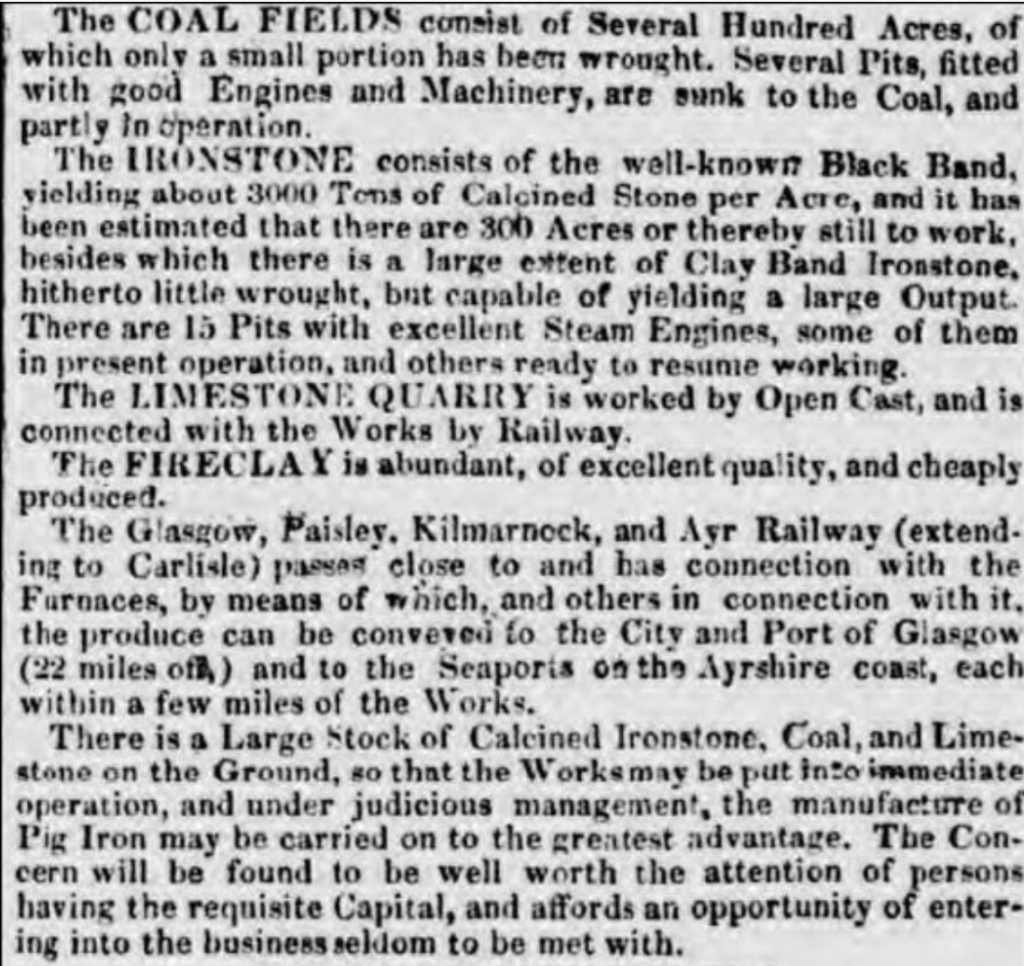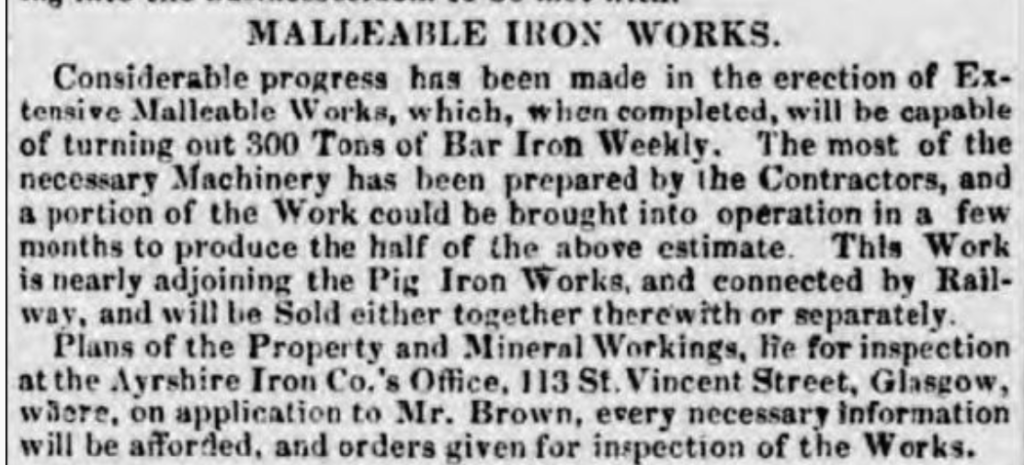BOYLE and Walker Occupations MINING
Gartsherrie is where James Boyle 2nd Great Grandfather was born 1823
Gartsherrie Colliery;
Gartsherrie
No.11. April 5. Robert Baird, Esq., 259, Argyll Street, partner in the Gartsherrie Iron Works and Collieries in the Airdrie District:
Says:- “there is not a worse place out of hell” than that neighbourhood and murders may be committed every day and never be heard of. They maintained some policemen a while but the county would not support them; they have a store in which two-thirds of the wages of the men who deal there is spent in drink; it destroys the men and they would give a good deal to prevent their drinking; he thinks as much as £7000 per week is spent in that district in drink; nothing would so increase the wealth of this nation as any reformation of these people; he thinks savings-banks would do good but they have not been well managed; he would have the power of licensing public-houses taken from the justices; they are most improperly lax in the regulating of them, the houses are as thronged on the Sabbath as any other day of the week; some of the older justices are respectable but they are afraid to interfere; the boys begin to drink and smoke at 10 years old; they have built a church belonging to the establishment; they have resisted the union amongst the colliers and no unionist is allowed to go down with them if known; they pay by the hundredweight for coals raised by each man so that he works only the regulated number of hutches, he may make them heavier or lighter as he pleases.
April 12. James Chalmers, collier, working with his two sons and 13 years old, in the Open-cast Pit, Gartsherrie:
He works six carts of 14cwt. a-day, three carts for himself and three for his two boys who are each “half a man.” They first came down at 10 years old; he was down to his work at 3 o’clock this morning and that is his general time and they work till 2 or 3 in the afternoon and all go up together. At 12, a boy is a half man; at 14, three-quarters; at 17, a whole man. “They rise over soon of a morning to go to a night-school.” They go to a Sabbath school, and both can read and write a little also. They go to bed between 6 and 7.
April 13. Janet Snedden, aged 9:
Is a trapper in the Gartsherrie Pit, No.1; comes down with Janet Ritchie, a single woman who hooks on and off the corves on the chain for drawing coal up the pit; comes down a quarter before 6 and goes up again about 4
________ Cameron:
Road-man and looks after workmen in the same pit; there are about 50 drawers in the pit [which I visited], 20 of them girls; we see two of them pushing a hutch both about 12, cousins, named Janet Mickley and Martha Paterson; it is about a year since most of the lasses came into this pit; the roads were getting far [i.e. long] and the lasses are not paid as high as boys would be; they come down between 4 and 5 and go up again about 3 p.m.; the engine stops from 12 to 1 for the horses, who draw the coal from the pit-head to the furnaces, to get their corn; it is between 500 and 600 fathoms from the pit to where the colliers are working the coal about two-thirds of a mile; [this distance we travelled two of us in a “whirly” pushed by a boy]. The collier is paid from 2s. 4d. to 2s. 6d. a ton for what he puts out and a single man’s “darg” [or days work] is from 4s. to 5s.; it takes the drawer half an hour to draw each hutch of coal from the face of the coal to the pit; this is the splint coals, the deepest worked here but the pit is cool and well ventilated.
April 13. George Lindsay.
Has been a collier 42 years. He began about 11 years of age to assist his father with a pick and in filling the hutches; at that time there were no railroads and they drew below ground with horses. To make the roads high enough they blew up the pavement. It was when the iron railways came in that “they were putting away” the horses and brought boys draw. There are more lasses now drawing in this pit than he remembers before in this part of the country. A great many of the colliers’ children begin to work when too young. He thinks 12 years old is as young as they ought to come down; he put some of his own sons in at eight years old, a weak one to help a strong one. Nine years since he wrought work at Mr. Dixon’s pit near Govan; he knows of no other where they work night and day. He made very good wages but he “did not love it,” it was not natural. He had two of his own sons drawing to him and they were the first to fail. They left him and then he was obliged to go also. Where he first worked was in Ayrshire for a country sale; there was no public work there and they did not spend so much of their money in drink as here.
April 12. Mr. M’Arthur.
He has a private day-school of about 120 scholars, in what was a hand-loom weaver’s shop, of which there were several here four years ago but very few now. He has been between four and five years teaching here; he distributes about 800 tracts monthly for the Glasgow Tract Society but he believes that eight out of ten to whom he gives them do not read them. He has to turn out two or three children from his school every day to wash their faces. The men often marry between 18 and 20 years of age and the parents thus find themselves with a family before they have experience to govern them properly. The mothers do not control their children properly nor allow him a sufficient authority over them. Much of the population is migratory, and on leaving a place they do not think much harm of leaving in debt, particularly the women. He thinks the system of stores attached to works has something to do with the constant changing of hands; they are allowed credit at the store, which they would not get as strangers at the shops; now if they were to remain long enough at a work to get credit in the neighbourhood, they might cease to deal at the store. He tried a night-school but he made nothing of it from the irregularity of attendance and the self-will of youths who had never been properly broken in; it ruins a nightschool, which ought to be chiefly devoted to teaching writing and arithmetic, to have children learning to read and thus disturbing the others and occupying the master; hence he often refused to admit those who could not read; there are two small schools where a few girls learn needlework. Drunkenness is the bane of the population; it is so common that “the being the worse for drink,” as they call it, is looked upon as no offence; two or three families will join in drinking whisky at home and even the children are dosed with it by their mothers as soon as they can gulp it down. The best paid drink the hardest, and those who earn moderate wages are often the most frugal; he has known a woman with a family who had eight lodgers, with only a room and a kitchen; thus they have no regard to comfort, but only think of gain. At Summerlee they have gardens to some of the houses and some of these were cultivated at first but the others pilfered things from them and so they were given up. There is no reading-room in the place, or musical or mechanics’ institute; the only recreations are dancing and playing at coits; things, however, are gradually improving; two churches and three Sabbath-schools have been created since he first knew the place.
http://www.scottishmining.co.uk/456.html
A FEW EXTRACTS from this excellent website. Many of the Scottish and Irish ancestors worked in the mines especially around West Lothian and Ayrshire. They were poor people and many of them emigrated to far flung places, Australia, America and Canada being the three most popular. http://www.scottishmining.co.uk/241.html
A topographical dictionary of Scotland, Samuel Lewis, 1846. Lothians
Armadale, a village, in the parish of Bathgate, county of Linlithgow, 2 miles (W.) from Bathgate; containing 121 inhabitants. This place derives its name from an estate in the vicinity, which once belonged to a senator in the college of justice whose title was Lord Armadale. The road from Linlithgow to Whitburn runs through the village, and it is also situated on the road between Edinburgh and Glasgow, from which cities it is nearly equidistant; the population is employed in agriculture, and in the mines and quarries of the neighbourhood.
Bonnyrigg, a village, in the parish of Cockpen, county of Edinburgh, 3 miles (N. W.) from Cockpen; containing 650 inhabitants. It is a considerable village, situated on the road between Laswade and Cockpen, in the northern part of the parish; and in the vicinity, are extensive coal-works. A school has been established here.
Langrigg, a village, in the parish of Whitburn, county of Linlithgow, 1 1/2 mile (S. by E.) from Whitburn; containing 225 inhabitants. It lies on the high road from Wilsontown to Linlithgow. Between this village and that of Fauldhouse is a valuable field of blackband ironstone, called the Crofthead, and lately discovered; it has led to great enterprise and industry in the district, of which the aspect has, in consequence, remarkably improved. In the neighbourhood of the village is a good stone-quarry. One of two libraries in the parish is at Langrigg.
Loanhead, a village, in the parish of Lasswade, county of Edinburgh, 1 1/4mile (W. by S.) from Lasswade; containing 810 inhabitants. This is a rural and pleasant village, situated a little east of the high road from Liberton to Penicuick, and is a favourite retreat in summer for families from the larger and more busy towns around, particularly Edinburgh, from which city it is distant between four and five miles. It contains a number of good houses and several handsome villas; and possesses the advantage, not usual in such small places, of an excellent supply of water, brought in pipes. In the neighbourhood are collieries, considerable paper-mills, and a brewery; employing a large part of the population. There is a Cameronian meeting-house; and the visitors have the benefit of a good subscription library.
Longniddry, a village, in the parish of Gladsmuir, county of Haddington, 4 miles (W. by N.) from Haddington; containing 216 inhabitants. This village, which is situated within half a mile of the Frith of Forth, is irregularly built. It appears to have been once of much greater extent than at present; a considerable portion of the site of ancient buildings is now in a state of cultivation; and in the memory of persons yet living there were several ranges of houses, the foundations of which have been obliterated by the plough. Part of the old mansion of the Douglases, here, is still occupied by a tenant; and near it are the remains of the ancient chapel, called, from his having preached in it, John Knox’s Kirk. A school, where about sixty children are instructed, has been long maintained in the village; the master has a house and garden rent free, with a payment of £4 per annum from the Earl of Wemyss and the proprietor, in addition to the fees.
Lugton, a village, in the parish of Dalkeith, county of Edinburgh, half a mile (N. W.) from Dalkeith; containing 230 inhabitants. The barony of Lugton was taken, in 1633, from the old parish of Melville, and annexed to this parish. The village is situated on the high road from Dalkeith to Edinburgh, and on the banks of the North Esk, over which river is a bridge, built in 1765, and widened in 1816, when, also, the approaches to it were improved. The inhabitants of the place are chiefly colliers, and a school has been established for their children.
Millerhill, Easter and Wester, villages, in the parish of Newton, county of Edinburgh, 1½ mile (N. W. by N.) from Dalkeith; the one containing 220, and the other 70, inhabitants. They lie in the south-eastern part of the parish, a short distance east of the village of Newton, and are chiefly inhabited by persons engaged in the coal-mines of the district.
Monktonhall, a village, in the parish of Inveresk, county of Edinburgh; 1 mile (S. S. W.) from Musselburgh; containing 117 inhabitants. This place lies nearly in the heart of the parish, a little to the south of the Esk river; it is the seat of one of the principal collieries in the parish, and its inhabitants are almost exclusively workers in the mines. About a mile above the village, on the Dalkeith road, stands Monkton House, said to have been built by the famous General Monk, and to have been his favourite Scottish residence. This venerable structure, now used as farm-offices, stands in the court of the present mansion-house, the property of Sir John Hope, Bart. The gardens of Monktonhall, and those of Stoneyhill, in the vicinity, appear to have been among the earliest in Scotland.
Newbattle, a parish, in the county of Edinburgh; containing, with the villages of Easthouses and Newton-Grange, 2033 inhabitants, of whom 159 are in the village of Newbattle, 1 mile (S.) from Dalkeith. This place, which forms a kind of suburb to the town of Dalkeith, originated in the foundation of a monastery by David I. in 1140, which he endowed for brethren of the Cistercian order, from the abbey of Melrose. The institution continued to flourish till the Dissolution, when its revenue was returned at £1413 in money, and various payments in kind. At the Reformation, the small parish of Maisterton was joined to this parish, and the church of the abbey was made parochial. The patronage of the united church, with the lands of Maisterton, and the manor of Newbattle, was held by Mark Kerr, the last commendator of the abbey, and ancestor of the Lothian family,
Newton, a village, in the parish of Pencaitland, county of Haddington, 1 mile (S.) from Penston; containing 168 inhabitants. It lies in the northern part of the parish, and, as its name implies, is of recent origin, having been built for the accommodation of the numerous persons employed in the collieries of the district. A school for the instruction of the children of the colliers has been for some time established here; the master receives an annual donation from Lady Ruthven and the lessee of the collieries, in addition to the fees, by which he is chiefly supported.
Niddry, a village, in the parish of Kirkliston, county of Linlithgow, 2 miles (W.) from the village of Kirkliston; containing 111 inhabitants. The head of the barony of Niddry was anciently hereditary bailie of the ecclesiastical regality of Kirkliston; and it is mentioned that during the reign of David II., Alexander Seton granted to Ade Forest two ploughs of land in the town of Niddry. The ancient and celebrated castle stands a little to the south of the Edinburgh and Linlithgow road: it was at one time possessed by the earls of Wintoun; and Mary, Queen of Scots, rested, and, it is said, slept, at this castle when on her flight from Lochleven to join her adherents at Hamilton, on the 2nd of May, 1568. It is now the property of the Earl of Hopetoun, and is a fine old ruin. The noble earl derives his title of Baron Niddry from this pla
